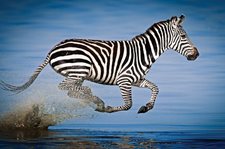
When United Nations delegates met in Stockholm in 1972 to choose World Heritage Sites, Africa's Serengeti topped almost every list. Is it any wonder? In addition to the majestic beauty of the 12,000 square mile ecosystem that spans northern Tanzania and Southwestern Kenya, the Serengeti is the scene each year of the most dramatic and dynamic animal migration on earth.
Many first-time visitors to Africa assume that the Great Migration is older than time, but in fact it has only been happening since 1960, a sad fact that suggests a heavy human footprint is one of the root causes behind this massive drive of wildebeests, zebras, and other mammals to seek rain and more verdant pastures. Despite the relative newness of the phenomenon, the Great Migration is an astonishing example of how different species’ instincts can be in total sync, but also how they work together to endure this challenging journey in a truly extraordinary and very elegant symbiosis.
The Great Migration is a yearlong phenomenon in which millions of animals move in a clockwise ellipse from north to south and back again, in pursuit of the rains and green pastures. In the vanguard are some 300 thousand zebras, acting as mowing machines as they munch the high grass of the Ndutu plains, allowing the tender green shoots to grow in their place. These are the special of the day for the stars of the show, who come right behind the zebras: between 1.5 and 2 million wildebeests, who almost simultaneously drop their young - over half a million calves - within three short weeks of each other. This is the portion of Great Migration that attracts the most visitors, as the animals nurture their young, ever watchful of the predators lurking on the periphery: lions, cheetahs, and others.
One of the more hazardous episodes of the Great Migration is the perfect place to witness extraordinary cooperation between different species. The Grumet River is full of ravenous crocodiles, poised to make a meal of any hapless wildebeest or zebra as they cross the river. But the mammals have a secret weapon in the flocks of birds, who signal them when a crocodile is lying in wait in the shallows.
Experience the grandeur and magnificence of The Great Migration on Alexander+Robert's select Small Group Journey,
On Safari in Kenya & Tanzania.